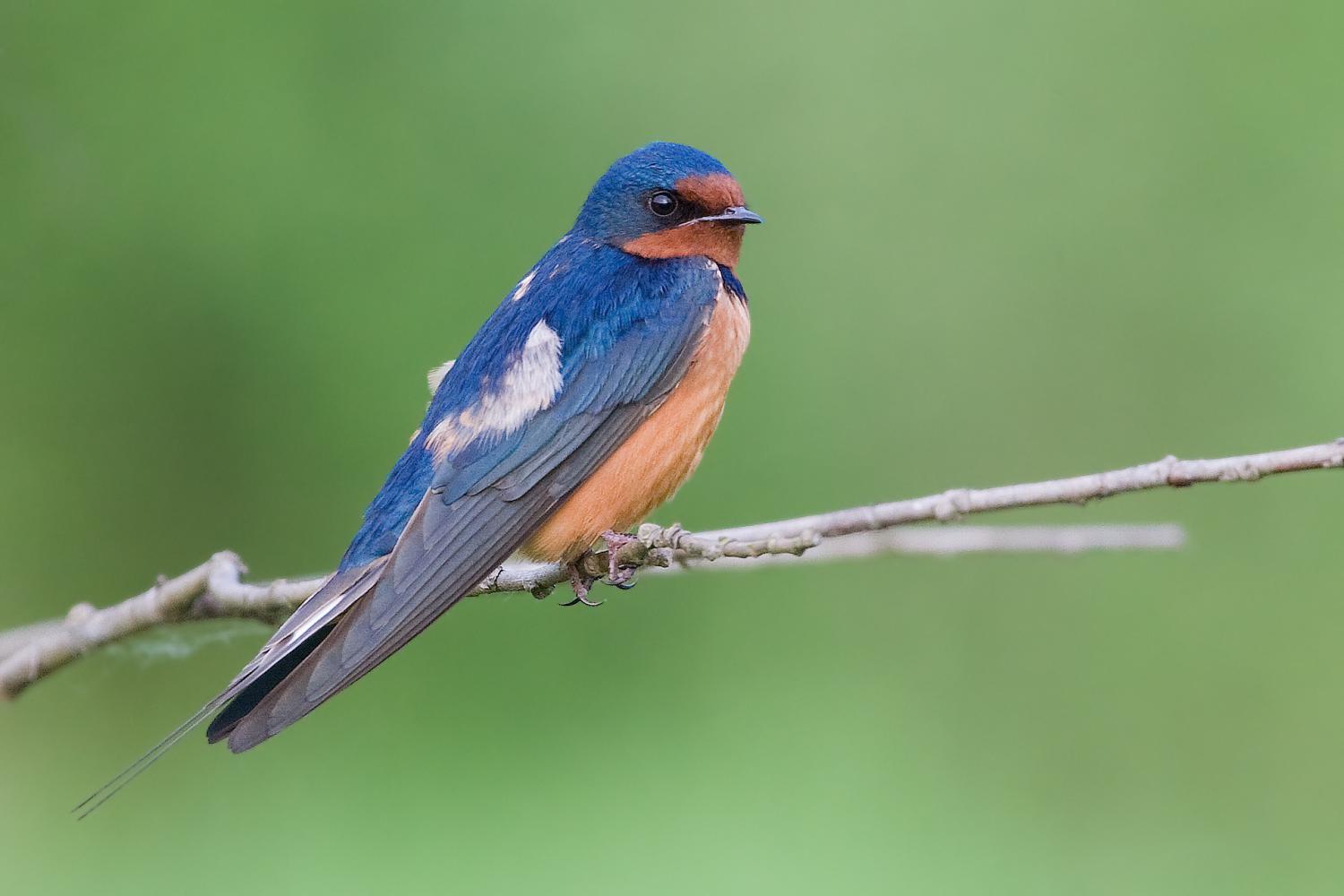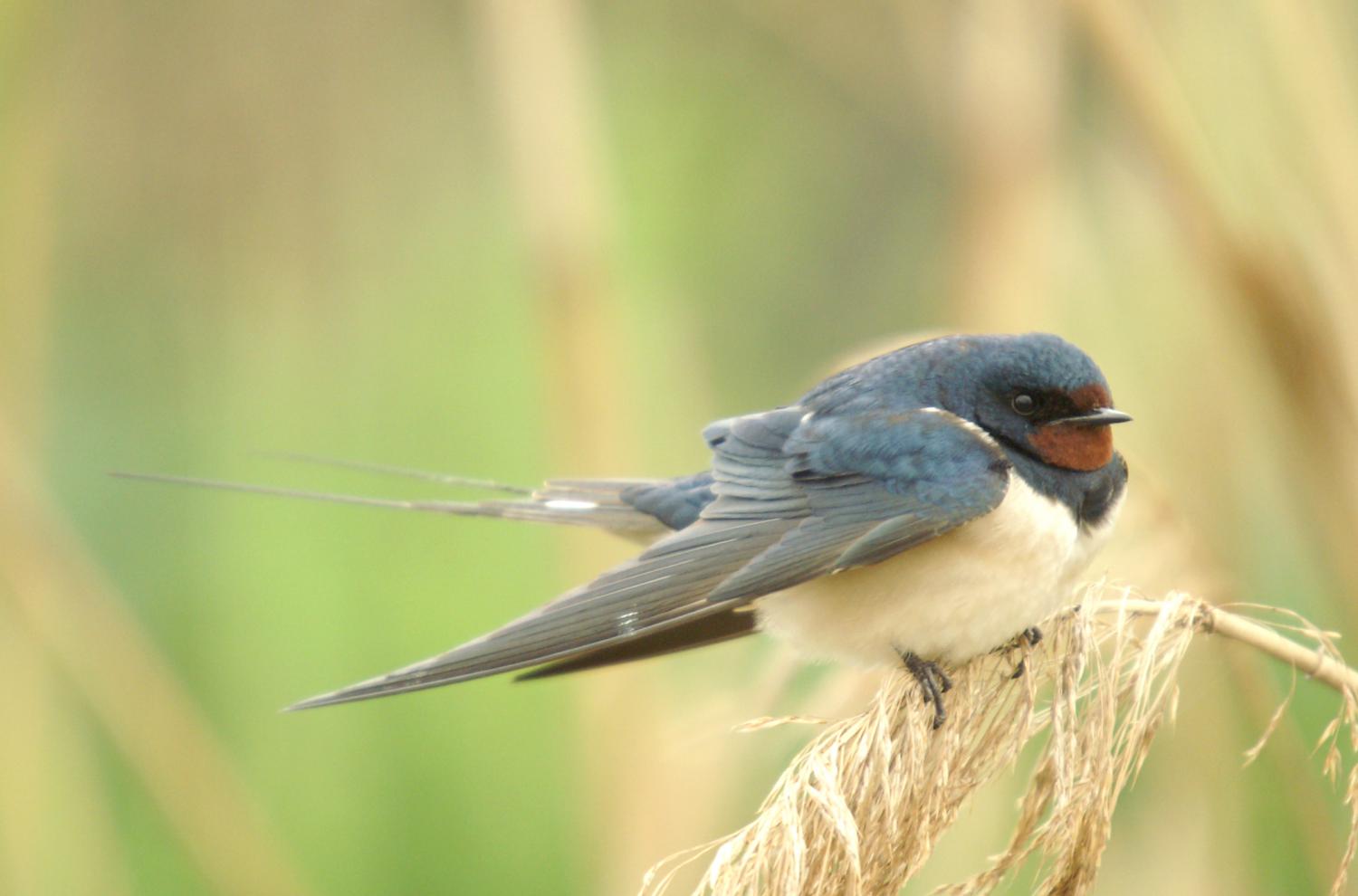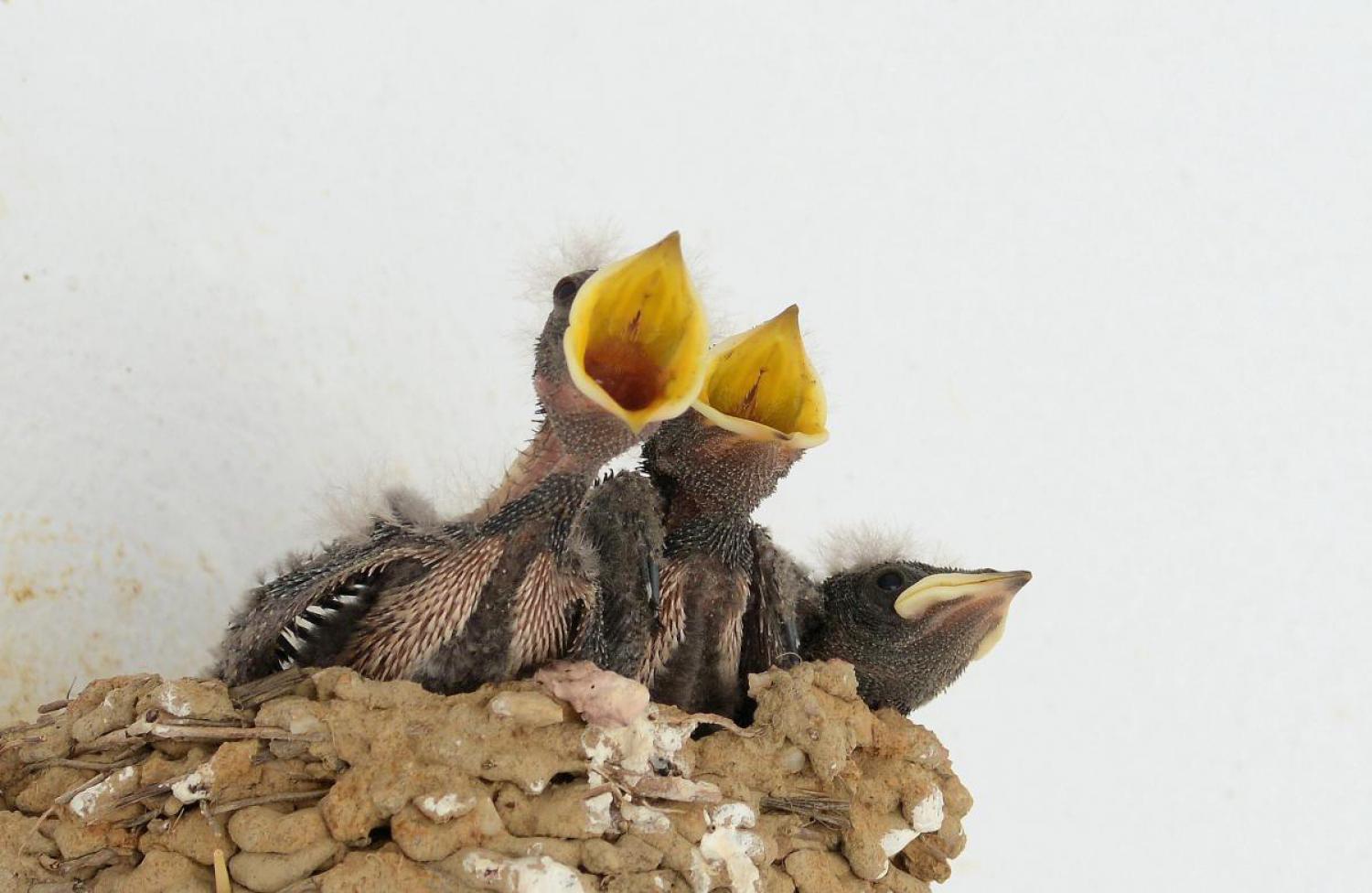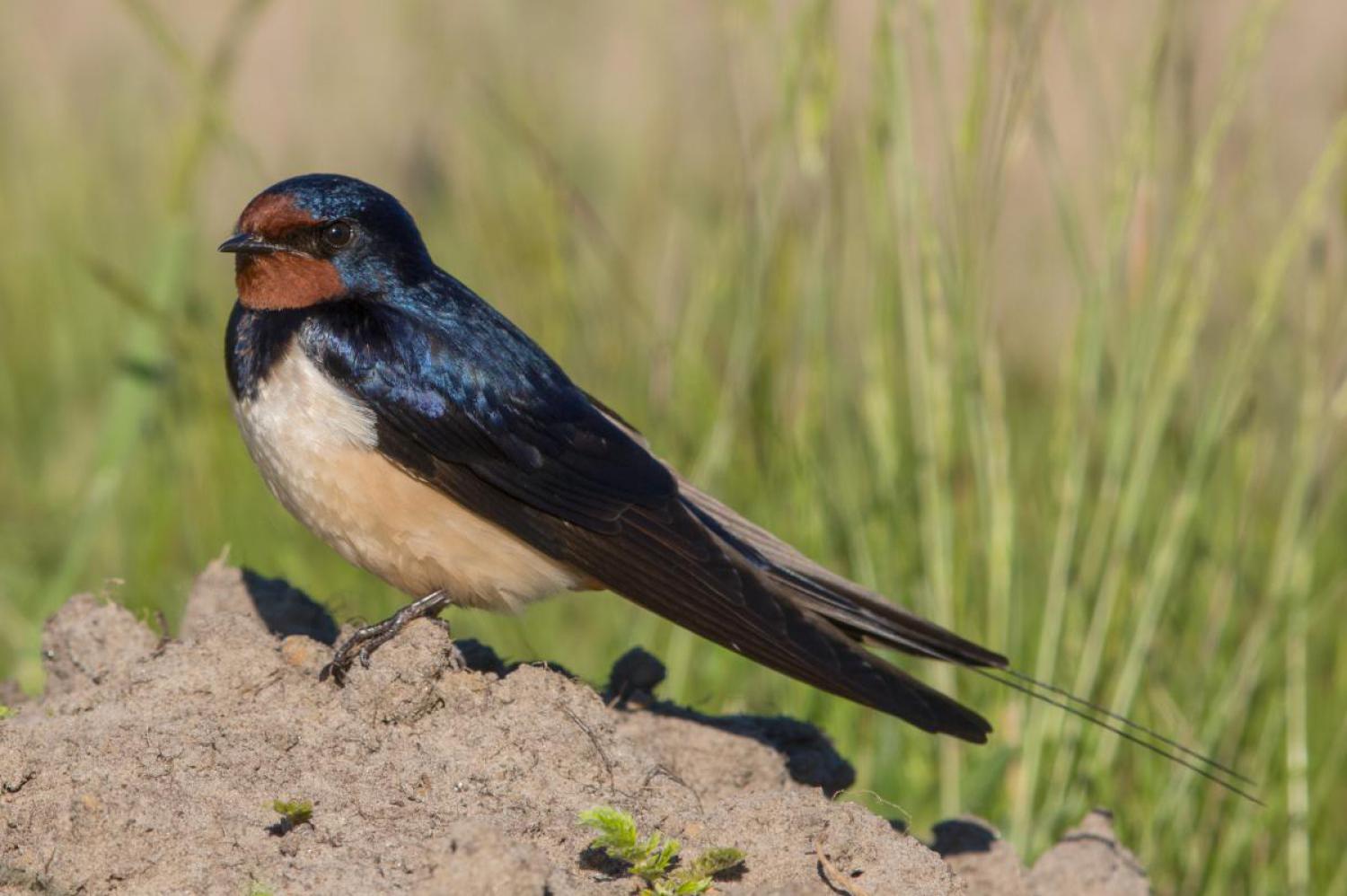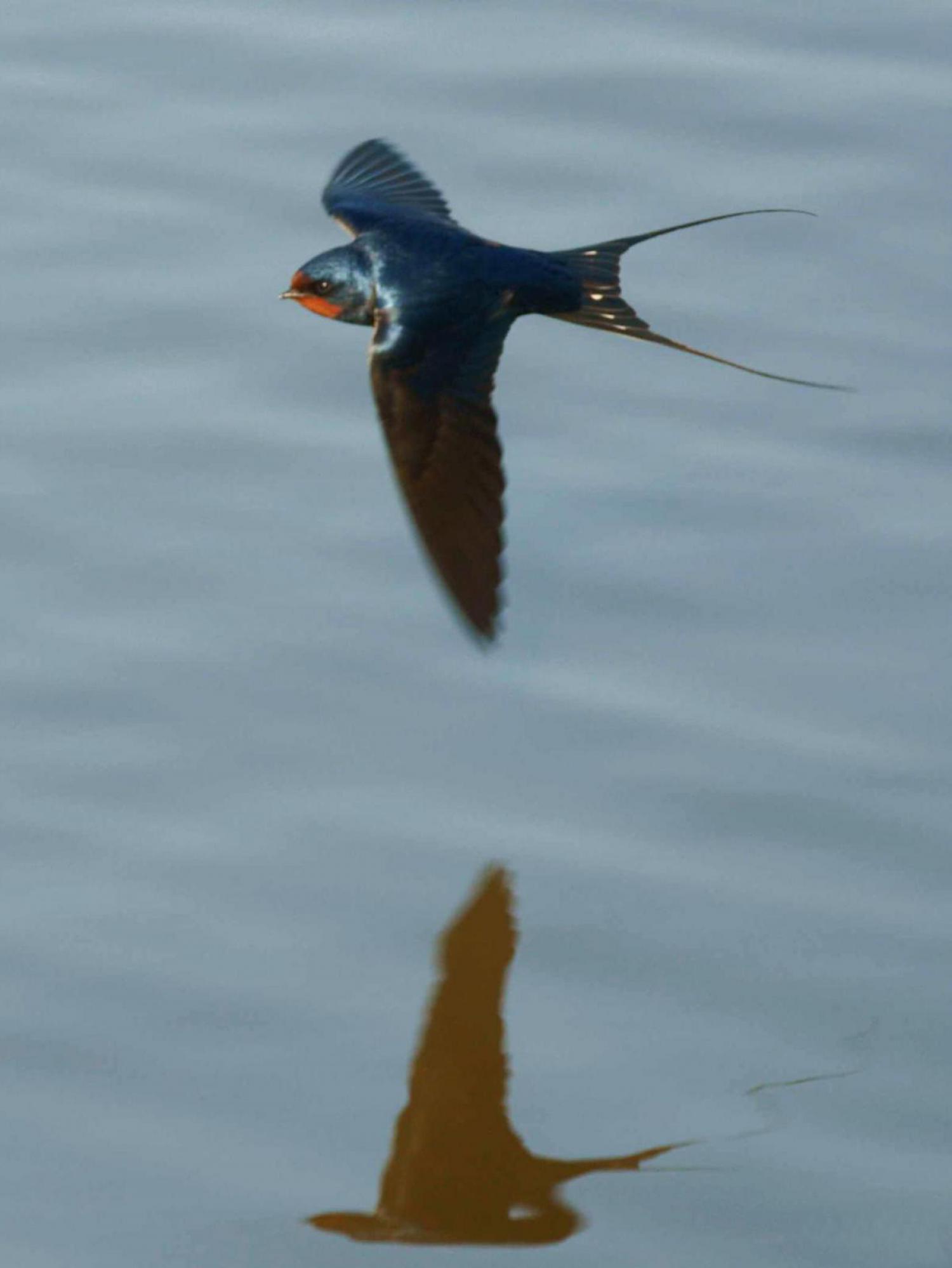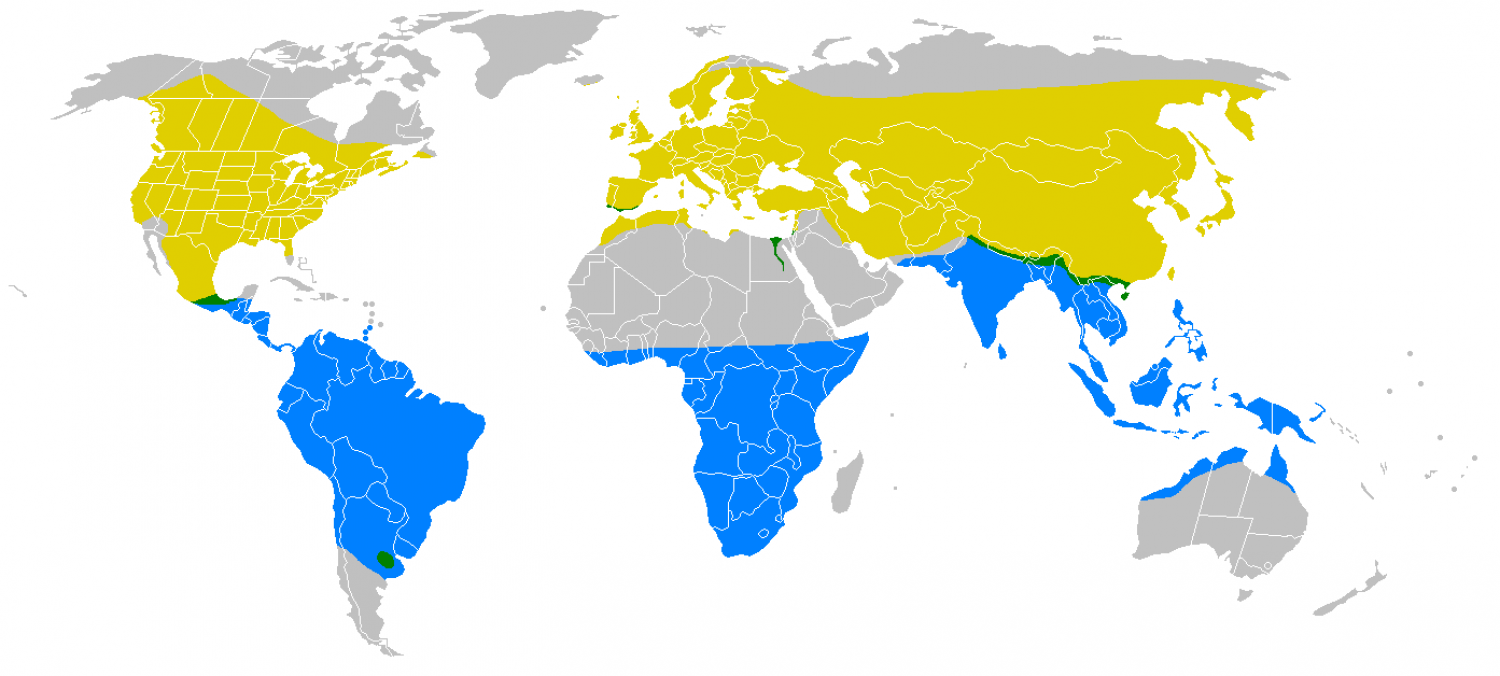Species of Thailand
Barn swallow
Hirundo rustica
Carolus Linnaeus, 1758
In Thai: นกนางแอ่นบ้าน
The barn swallow (Hirundo rustica) is the most widespread species of swallow in the world. It is a distinctive passerine bird with blue upperparts and a long, deeply forked tail. It is found in Europe, Asia, Africa and the Americas. In Anglophone Europe it is just called the swallow; in Northern Europe it is the only common species called a "swallow" rather than a "martin".
There are six subspecies of barn swallow, which breed across the Northern Hemisphere. Four are strongly migratory, and their wintering grounds cover much of the Southern Hemisphere as far south as central Argentina, the Cape Province of South Africa, and northern Australia. Its huge range means that the barn swallow is not endangered, although there may be local population declines due to specific threats.
The barn swallow is a bird of open country that normally uses man-made structures to breed and consequently has spread with human expansion. It builds a cup nest from mud pellets in barns or similar structures and feeds on insects caught in flight. This species lives in close association with humans, and its insect-eating habits mean that it is tolerated by humans; this acceptance was reinforced in the past by superstitions regarding the bird and its nest. There are frequent cultural references to the barn swallow in literary and religious works due to both its living in close proximity to humans and its annual migration. The barn swallow is the national bird of Austria and Estonia.
Description
The adult male barn swallow of the nominate subspecies H. r. rustica is 17 – 19 cm long including 2 – 7 cm of elongated outer tail feathers. It has a wingspan of 32 – 34.5 cm and weighs 16 – 22 g. It has steel blue upperparts and a rufous forehead, chin and throat, which are separated from the off-white underparts by a broad dark blue breast band. The outer tail feathers are elongated, giving the distinctive deeply forked "swallow tail". There is a line of white spots across the outer end of the upper tail. The female is similar in appearance to the male, but the tail streamers are shorter, the blue of the upperparts and breast band is less glossy, and the underparts paler. The juvenile is browner and has a paler rufous face and whiter underparts. It also lacks the long tail streamers of the adult.
The song of the male barn swallow is a cheerful warble, often ending with su-seer with the second note higher than the first but falling in pitch. Calls include witt or witt-witt and a loud splee-plink when excited (or trying to chase intruders away from the nest). The alarm calls include a sharp siflitt for predators like cats and a flitt-flitt for birds of prey like the hobby. This species is fairly quiet on the wintering grounds.
The distinctive combination of a red face and blue breast band render the adult barn swallow easy to distinguish from the African Hirundo species and from the welcome swallow (Hirundo neoxena) with which its range overlaps in Australasia. In Africa the short tail streamers of the juvenile barn swallow invite confusion with juvenile red-chested swallow (Hirundo lucida), but the latter has a narrower breast band and more white in the tail.
Taxonomy
The barn swallow was described by Carl Linnaeus in his 1758 10th edition of Systema Naturae as Hirundo rustica, characterised as "H. rectricibus, exceptis duabus intermediis, macula alba notatîs". Hirundo is the Latin word for "swallow"; rusticus means "of the country". This species is the only one of that genus to have a range extending into the Americas, with the majority of Hirundo species being native to Africa. This genus of blue-backed swallows is sometimes called the "barn swallows".
The Oxford English Dictionary dates the English common name "barn swallow" to 1851, though an earlier instance of the collocation in an English-language context is in Gilbert White's popular book The Natural History of Selborne, originally published in 1789:
The swallow, though called the chimney-swallow, by no means builds altogether in chimnies , but often within barns and out-houses against the rafters ... In Sweden she builds in barns, and is called ladusvala, the barn-swallow.
This suggests that the English name may be a calque on the Swedish term.
There are few taxonomic problems within the genus, but the red-chested swallow—a resident of West Africa, the Congo basin, and Ethiopia—was formerly treated as a subspecies of barn swallow. The red-chested swallow is slightly smaller than its migratory relative, has a narrower blue breast-band, and (in the adult) has shorter tail streamers. In flight, it looks paler underneath than barn swallow.
Subspecies
Six subspecies of barn swallow are generally recognised. In eastern Asia, a number of additional or alternative forms have been proposed, including saturata by Robert Ridgway in 1883, kamtschatica by Benedykt Dybowski in 1883, ambigua by Erwin Stresemann and mandschurica by Wilhelm Meise in 1934. Given the uncertainties over the validity of these forms, this article follows the treatment of Turner and Rose.
- H. r. rustica, the nominate European subspecies, breeds in Europe and Asia, as far north as the Arctic Circle, south to North Africa, the Middle East and Sikkim, and east to the Yenisei River. It migrates on a broad front to winter in Africa, Arabia, and the Indian subcontinent. The barn swallows wintering in southern Africa are from across Eurasia to at least 91°E, and have been recorded as covering up to 11660 km on their annual migration. The nominate European subspecies was the first to have its genome sequenced and published.
- H. r. transitiva was described by Ernst Hartert in 1910. It breeds in the Middle East from southern Turkey to Israel and is partially resident, though some birds winter in East Africa. It has orange red underparts and a broken breast band.
- H. r. savignii, the resident Egyptian subspecies, was described by James Stephens in 1817 and named for French zoologist Marie Jules César Savigny. It resembles transitiva, which also has orange-red underparts, but savignii has a complete broad breast band and deeper red hue to the underparts.
- H. r. gutturalis, described by Giovanni Antonio Scopoli in 1786, has whitish underparts and a broken breast band. Breast chestnut and lower underparts more pink-buff. The populations that breed in the central and eastern Himalayas have been included in this subspecies, although the primary breeding range is Japan and Korea. The east Asian breeders winter across tropical Asia from India and Sri Lanka east to Indonesia and New Guinea. Increasing numbers are wintering in Australia. It hybridises with H. r. tytleri in the Amur River area. It is thought that the two eastern Asia forms were once geographically separate, but the nest sites provided by expanding human habitation allowed the ranges to overlap. H. r. gutturalis is a vagrant to Alaska and Washington, but is easily distinguished from the North American breeding subspecies, H. r. erythrogaster, by the latter's reddish underparts.
- H. r. tytleri, first described by Thomas Jerdon in 1864, and named for British soldier, naturalist and photographer Robert Christopher Tytler, has deep orange-red underparts and an incomplete breast band. The tail is also longer. It breeds in central Siberia south to northern Mongolia and winters from eastern Bengal east to Thailand and Malaysia.
- H. r. erythrogaster, the North American subspecies described by Pieter Boddaert in 1783, differs from the European subspecies in having redder underparts and a narrower, often incomplete, blue breast band. It breeds throughout North America, from Alaska to southern Mexico, and migrates to the Lesser Antilles, Costa Rica, Panama and South America to winter. A few may winter in the southernmost parts of the breeding range. This subspecies funnels through Central America on a narrow front and is therefore abundant on passage in the lowlands of both coasts.
The short wings, red belly and incomplete breast band of H. r. tytleri are also found in H. r. erythrogaster, and DNA analyses show that barn swallows from North America colonised the Baikal region of Siberia, a dispersal direction opposite to that for most changes in distribution between North America and Eurasia.
Habitat and range
The preferred habitat of the barn swallow is open country with low vegetation, such as pasture, meadows and farmland, preferably with nearby water. This swallow avoids heavily wooded or precipitous areas and densely built-up locations. The presence of accessible open structures such as barns, stables, or culverts to provide nesting sites, and exposed locations such as wires, roof ridges or bare branches for perching, are also important in the bird's selection of its breeding range.
It breeds in the Northern Hemisphere from sea level to typically 2700 m, but to 3000 m in the Caucasus and North America, and it is absent only from deserts and the cold northernmost parts of the continents. Over much of its range, it avoids towns, and in Europe is replaced in urban areas by the house martin. However, in Honshū, Japan, the barn swallow is a more urban bird, with the red-rumped swallow (Cecropis daurica) replacing it as the rural species.
In winter, the barn swallow is cosmopolitan in its choice of habitat, avoiding only dense forests and deserts. It is most common in open, low vegetation habitats, such as savanna and ranch land, and in Venezuela, South Africa and Trinidad and Tobago it is described as being particularly attracted to burnt or harvested sugarcane fields and the waste from the cane. In the absence of suitable roost sites, they may sometimes roost on wires where they are more exposed to predators. Individual birds tend to return to the same wintering locality each year and congregate from a large area to roost in reed beds. These roosts can be extremely large; one in Nigeria had an estimated 1.5 million birds. These roosts are thought to be a protection from predators, and the arrival of roosting birds is synchronised in order to overwhelm predators like African hobbies. The barn swallow has been recorded as breeding in the more temperate parts of its winter range, such as the mountains of Thailand and in central Argentina.
Migration of barn swallows between Britain and South Africa was first established on 23 December 1912 when a bird that had been ringed by James Masefield at a nest in Staffordshire, was found in Natal. As would be expected for a long-distance migrant, this bird has occurred as a vagrant to such distant areas as Hawaii, Bermuda, Greenland, Tristan da Cunha the Falkland Islands, and even Antarctica.
Feeding
The barn swallow is similar in its habits to other aerial insectivores, including other swallow species and the unrelated swifts. It is not a particularly fast flier, with a speed estimated at about 11 m/s mi/h, up to 20 m/s mi/h and a wing beat rate of approximately 5, up to 7–9 times each second.
The barn swallow typically feeds in open areas 7 – 8 m above shallow water or the ground often following animals, humans or farm machinery to catch disturbed insects, but it will occasionally pick prey items from the water surface, walls and plants. In the breeding areas, large flies make up around 70% of the diet, with aphids also a significant component. However, in Europe, the barn swallow consumes fewer aphids than the house or sand martins. On the wintering grounds, Hymenoptera, especially flying ants, are important food items. When egg-laying barn swallows hunt in pairs, but otherwise will form often large flocks.
The amount of food a clutch will get depends on the size of the clutch, with larger clutches getting more food on average. The timing of a clutch also determines the food given; later broods get food that is smaller in size compared to earlier broods. This is because larger insects are too far away from the nest to be profitable in terms of energy expenditure.
Isotope studies have shown that wintering populations may utilise different feeding habitats, with British breeders feeding mostly over grassland, whereas Swiss birds utilised woodland more. Another study showed that a single population breeding in Denmark actually wintered in two separate areas.
The barn swallow drinks by skimming low over lakes or rivers and scooping up water with its open mouth. This bird bathes in a similar fashion, dipping into the water for an instant while in flight.
Swallows gather in communal roosts after breeding, sometimes thousands strong. Reed beds are regularly favoured, with the birds swirling en masse before swooping low over the reeds. Reed beds are an important source of food prior to and whilst on migration; although the barn swallow is a diurnal migrant that can feed on the wing whilst it travels low over ground or water, the reed beds enable fat deposits to be established or replenished.
Breeding
The male barn swallow returns to the breeding grounds before the females and selects a nest site, which is then advertised to females with a circling flight and song. Plumage may be used to advertise: in some populations, like in the subspecies H. r. gutturalis, darker ventral plumage in males is associated with higher breeding success. In other populations, the breeding success of the male is related to the length of the tail streamers, with longer streamers being more attractive to the female. Males with longer tail feathers are generally longer-lived and more disease resistant, females thus gaining an indirect fitness benefit from this form of selection, since longer tail feathers indicate a genetically stronger individual which will produce offspring with enhanced vitality. Males in northern Europe have longer tails than those further south; whereas in Spain the male's tail streamers are only 5% longer than the female's, in Finland the difference is 20%. In Denmark, the average male tail length increased by 9% between 1984 and 2004, but it is possible that climatic changes may lead in the future to shorter tails if summers become hot and dry.
Males with long streamers also have larger white tail spots, and since feather-eating bird lice prefer white feathers, large white tail spots without parasite damage again demonstrate breeding quality; there is a positive association between spot size and the number of offspring produced each season.
The breeding season of the barn swallow is variable; in the southern part of the range, the breeding season usually is from February or March to early to mid September, although some late second and third broods finish in October. In the northern part of the range, it usually starts late May to early June and ends the same time as the breeding season of the southernmost birds.
Both sexes defend the nest, but the male is particularly aggressive and territorial. Once established, pairs stay together to breed for life, but extra-pair copulation is common, making this species genetically polygamous, despite being socially monogamous. Males guard females actively to avoid being cuckolded. Males may use deceptive alarm calls to disrupt extrapair copulation attempts toward their mates.
As its name implies, the barn swallow typically nests inside accessible buildings such as barns and stables, or under bridges and wharves. Before man-made sites became common, it nested on cliff faces or in caves, but this is now rare. The neat cup-shaped nest is placed on a beam or against a suitable vertical projection. It is constructed by both sexes, although more often by the female, with mud pellets collected in their beaks and lined with grasses, feathers, algae or other soft materials. The nest building ability of the male is also sexually selected; females will lay more eggs and at an earlier date with males who are better at nest construction, with the opposite being true with males that are not. After building the nest, barn swallows may nest colonially where sufficient high-quality nest sites are available, and within a colony, each pair defends a territory around the nest which, for the European subspecies, is 4 to 8 m2 in size. Colony size tends to be larger in North America.
In North America at least, barn swallows frequently engage in a mutualist relationship with ospreys. Barn swallows will build their nest below an osprey nest, receiving protection from other birds of prey that are repelled by the exclusively fish-eating ospreys. The ospreys are alerted to the presence of these predators by the alarm calls of the swallows.
There are normally two broods, with the original nest being reused for the second brood and being repaired and reused in subsequent years. The female lays two to seven, but typically four or five, reddish-spotted white eggs. The clutch size is influenced by latitude, with clutch sizes of northern populations being higher on average than southern populations. The eggs are 20 x 14 mm in size, and weigh 1.9 g, of which 5% is shell. In Europe, the female does almost all the incubation, but in North America the male may incubate up to 25% of the time. The incubation period is normally 14–19 days, with another 18–23 days before the altricial chicks fledge. The fledged young stay with, and are fed by, the parents for about a week after leaving the nest. Occasionally, first-year birds from the first brood will assist in feeding the second brood. Compared to those from early broods, juvenile barn swallows from late broods have been found to migrate at a younger age, fuel less efficiently during migration and have lower return rates the following year.
The barn swallow will mob intruders such as cats or accipiters that venture too close to their nest, often flying very close to the threat. Adult barn swallows have few predators, but some are taken by accipiters, falcons, and owls. Brood parasitism by cowbirds in North America or cuckoos in Eurasia is rare.
Hatching success is 90% and the fledging survival rate is 70–90%. Average mortality is 70–80% in the first year and 40–70% for the adult. Although the record age is more than 11 years, most survive less than four years. Barn swallow nestlings have prominent red gapes, a feature shown to induce feeding by parent birds. An experiment in manipulating brood size and immune system showed the vividness of the gape was positively correlated with T-cell–mediated immunocompetence, and that larger brood size and injection with an antigen led to a less vivid gape.
The barn swallow has been recorded as hybridising with the cliff swallow (Petrochelidon pyrrhonota) and the cave swallow (P. fulva) in North America, and the house martin (Delichon urbicum) in Eurasia, the cross with the latter being one of the most common passerine hybrids.
Parasites and predators
Barn swallows (and other small passerines) often have characteristic feather holes on their wing and tail feathers. These holes were suggested as being caused by avian lice such as Machaerilaemus malleus and Myrsidea rustica, although other studies suggest that they are mainly caused by species of Brueelia. Several other species of lice have been described from barn swallow hosts, including Brueelia domestica and Philopterus microsomaticus. The avian lice prefer to feed on white tail spots, and they are generally found more numerously on short-tailed males, indicating the function of unbroken white tail spots as a measure of quality. In Texas, the swallow bug (Oeciacus vicarius), which is common on species such as the cliff swallow, is also known to infest barn swallows.
Predatory bats such as the greater false vampire bat are known to prey on barn swallows. Swallows at their communal roosts attract predators and several falcon species make use of these opportunities. Falcon species confirmed as predators include the peregrine falcon and the African hobby.
Status
The barn swallow has an enormous range, with an estimated global extent of 51700000 km2 and a population of 190 million individuals. The species is evaluated as least concern on the 2007 IUCN Red List, and has no special status under the Convention on International Trade in Endangered Species of Wild Fauna and Flora (CITES), which regulates international trade in specimens of wild animals and plants.
This is a species that has greatly benefited historically from forest clearance, which has created the open habitats it prefers, and from human habitation, which have given it an abundance of safe man-made nest sites. There have been local declines due to the use of DDT in Israel in the 1950s, competition for nest sites with house sparrows in the US in the 19th century, and an ongoing gradual decline in numbers in parts of Europe and Asia due to agricultural intensification, reducing the availability of insect food. However, there has been an increase in the population in North America during the 20th century with the greater availability of nesting sites and subsequent range expansion, including the colonisation of northern Alberta.
A specific threat to wintering birds from the European populations is the transformation by the South African government of a light aircraft runway near Durban into an international airport for the 2010 FIFA World Cup. The roughly 250 m yd square Mount Moreland reed bed is a night roost for more than three million barn swallows, which represent 1% of the global population and 8% of the European breeding population. The reed bed lies on the flight path of aircraft using the proposed La Mercy airport, and there were fears that it would be cleared because the birds could threaten aircraft safety. However, following detailed evaluation, advanced radar technology will be installed to enable planes using the airport to be warned of bird movements and, if necessary, take appropriate measures to avoid the flocks.
Climate change may affect the barn swallow; drought causes weight loss and slow feather regrowth, and the expansion of the Sahara will make it a more formidable obstacle for migrating European birds. Hot dry summers will reduce the availability of insect food for chicks. Conversely, warmer springs may lengthen the breeding season and result in more chicks, and the opportunity to use nest sites outside buildings in the north of the range might also lead to more offspring.
Relationship with humans
The barn swallow is an attractive bird that feeds on flying insects and has therefore been tolerated by humans when it shares their buildings for nesting. As one of the earlier migrants, this conspicuous species is also seen as an early sign of summer's approach.
In the Old World, the barn swallow appears to have used man-made structures and bridges since time immemorial. An early reference is in Virgil's Georgics (29 BC), "Ante garrula quam tignis nidum suspendat hirundo" (Before the twittering swallow hangs its nest from the rafters).
Many cattle farmers believed that swallows spread Salmonella infections, however a study in Sweden showed no evidence of the birds being reservoirs of the bacteria.
In literature
Many literary references are based on the barn swallow's northward migration as a symbol of spring or summer. The proverb about the necessity for more than one piece of evidence goes back at least to Aristotle's Nicomachean Ethics: "For as one swallow or one day does not make a spring, so one day or a short time does not make a fortunate or happy man."
The barn swallow symbolises the coming of spring and thus love in the Pervigilium Veneris, a late Latin poem. In his poem "The Waste Land", T. S. Eliot quoted the line "Quando fiam uti chelidon ?" ("When will I be like the swallow, so that I can stop being silent?") This refers to the myth of Philomela in which she turns into a nightingale, and her sister Procne into a swallow. On the other hand, an image of the assembly of swallows for their southward migration concludes John Keats's ode "To Autumn".
The swallow is cited in several of William Shakespeare's plays for the swiftness of its flight, with "True hope is swift, and flies with swallow's wings" from Act 5 of Richard III, and "I have horse will follow where the game Makes way, and run like swallows o'er the plain." from the second act of Titus Andronicus. Shakespeare references the annual migration of the species in The Winter's Tale, Act 4: "Daffodils, That come before the swallow dares, and take The winds of March with beauty".
A swallow is the main character in Oscar Wilde's story, The Happy Prince.
In culture
Gilbert White studied the barn swallow in detail in his pioneering work The Natural History of Selborne, but even this careful observer was uncertain whether it migrated or hibernated in winter. Elsewhere, its long journeys have been well observed, and a swallow tattoo is popular amongst nautical men as a symbol of a safe return; the tradition was that a mariner had a tattoo of this fellow wanderer after sailing 5000 nmi km mi. A second swallow would be added after 10000 nmi km mi at sea. In the past, the tolerance for this beneficial insectivore was reinforced by superstitions regarding damage to the barn swallow's nest. Such an act might lead to cows giving bloody milk, or no milk at all, or to hens ceasing to lay. This may be a factor in the longevity of swallows' nests. Survival, with suitable annual refurbishment, for 10–15 years is regular, and one nest was reported to have been occupied for 48 years.
It is depicted as the martlet, merlette or merlot in heraldry, where it represents younger sons who have no lands. It is also represented as lacking feet as this was a common belief at the time. As a result of a campaign by ornithologists, the barn swallow has been the national bird of Estonia since 23 June 1960.
Barn swallows on postage stamps
Barn swallows are one of the most depicted birds on postage stamps around the world.
This article uses material from Wikipedia released under the Creative Commons Attribution-Share-Alike Licence 3.0. Eventual photos shown in this page may or may not be from Wikipedia, please see the license details for photos in photo by-lines.
Category / Seasonal Status
Wiki listed status (concerning Thai population): Winter visitor
BCST Category: Recorded in an apparently wild state within the last 50 years
BCST Seasonal statuses:
- Resident or presumed resident
- Non-breeding visitor
Scientific classification
- Kingdom
- Animalia
- Phylum
- Chordata
- Class
- Aves
- Order
- Passeriformes
- Family
- Hirundinidae
- Genus
- Hirundo
- Species
- Hirundo rustica
Common names
- English:
- Barn swallow
- European swallow
- Swallow
- French: Hirondelle de cheminée
- Thai: นกนางแอ่นบ้าน
Synonyms
- Hirundo erythrogaster
Conservation status

Least Concern (IUCN3.1)
Photos
Please help us review the bird photos if wrong ones are used. We can be reached via our contact us page.
Range Map
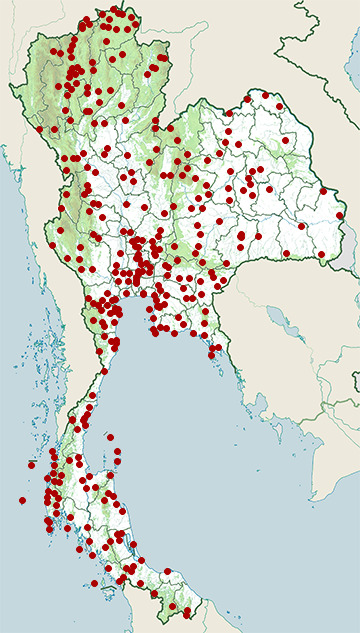
- Amphawa District, Samut Songkhram
- Ao Phang-Nga National Park
- Aranyaprathet District, Sa Kaeo
- Ban Bueng District, Chonburi
- Ban Chang District, Rayong
- Ban Hong Non-Hunting Area
- Ban Laem District, Phetchaburi
- Ban Lat District, Phetchaburi
- Ban Lueam District, Nakhon Ratchasima
- Ban Phai District, Khon Kaen
- Ban Pho District, Chachoengsao
- Ban Phraek District, Phra Nakhon Si Ayutthaya
- Ban Sang District, Prachinburi
- Bang Ban District, Phra Nakhon Si Ayutthaya
- Bang Kruai District, Nonthaburi
- Bang Lamung District, Chonburi
- Bang Lang National Park
- Bang Len District, Nakhon Pathom
- Bang Pa In District, Phra Nakhon Si Ayutthaya
- Bang Pahan District, Phra Nakhon Si Ayutthaya
- Bang Pakong District, Chachoengsao
- Bang Phra Non-Hunting Area
- Bang Pu Recreation Centre
- Bang Saphan Noi District, Prachuap Khiri Khan
- Bangkok Province
- Borabue District, Maha Sarakham
- Bueng Boraped Non-Hunting Area
- Bueng Khong Long Non-Hunting Area
- Chae Son National Park
- Chaiya District, Surat Thani
- Chaiyo District, Ang Thong
- Chaloem Phra Kiat District, Saraburi
- Chaloem Phrakiat Thai Prachan National Park
- Chatturat District, Chaiyaphum
- Chiang Dao District, Chiang Mai
- Chiang Dao Wildlife Sanctuary
- Chiang Khong District, Chiang Rai
- Chiang Saen District, Chiang Rai
- Chum Ta Bong District, Nakhon Sawan
- Dan Chang District, Suphan Buri
- Doi Chong National Park
- Doi Inthanon National Park
- Doi Khun Tan National Park
- Doi Lang
- Doi Lo District, Chiang Mai
- Doi Pha Hom Pok National Park
- Doi Phu Kha National Park
- Doi Saket District, Chiang Mai
- Doi Suthep - Pui National Park
- Doi Tao District, Chiang Mai
- Erawan National Park
- Fang District, Chiang Mai
- Hala-Bala Wildlife Sanctuary
- Hang Chat District, Lampang
- Hat Wanakon National Park
- Hat Yai District, Songkhla
- Hua Hin District, Prachuap Khiri Khan
- Huai Chorakhe Mak Reservoir Non-Hunting Area
- Huai Kha Khaeng Wildlife Sanctuary
- Huai Nam Dang National Park
- Huai Sala Wildlife Sanctuary
- Huai Talat Reservoir Non-Hunting Area
- In Buri District, Sing Buri
- Kabin Buri District, Prachinburi
- Kaeng Khoi District, Saraburi
- Kaeng Khro District, Chaiyaphum
- Kaeng Krachan District, Phetchaburi
- Kaeng Krachan National Park
- Kaeng Krung National Park
- Kaeng Som Maew Queen Sirikit Forest Park
- Kamphaeng Saen District, Nakhon Pathom
- Kanthararom District, Sisaket
- Kantharawichai District, Maha Sarakham
- Kapong District, Phang Nga
- Kaset Sombun District, Chaiyaphum
- Khanom District, Nakhon Si Thammarat
- Khao Ang Rue Nai Wildlife Sanctuary
- Khao Banthat Wildlife Sanctuary
- Khao Dinsor (Chumphon Raptor Center)
- Khao Khiao - Khao Chomphu Wildlife Sanctuary
- Khao Khitchakut National Park
- Khao Laem National Park
- Khao Laem Ya - Mu Ko Samet National Park
- Khao Lak - Lam Ru National Park
- Khao Luang National Park
- Khao Nam Khang National Park
- Khao Nan National Park
- Khao Nang Phanthurat Forest Park
- Khao Phra - Bang Khram Wildlife Sanctuary
- Khao Sam Roi Yot National Park
- Khao Sanam Prieng Wildlife Sanctuary
- Khao Soi Dao Wildlife Sanctuary
- Khao Sok National Park
- Khao Yai National Park
- Khao Yoi District, Phetchaburi
- Khemarat District, Ubon Ratchathani
- Khlong Hoi Khong District, Songkhla
- Khlong Lan National Park
- Khlong Luang District, Pathum Thani
- Khlong Saeng Wildlife Sanctuary
- Khok Sung District, Sa Kaeo
- Khon San District, Chaiyaphum
- Khuan Khanun District, Phatthalung
- Khun Chae National Park
- Khun Nan National Park
- Khun Tan District, Chiang Rai
- Khung Kraben Non-Hunting Area
- Khura Buri District, Phang Nga
- Klaeng District, Rayong
- Ko Chang National Park
- Ko Lanta National Park
- Ko Libong
- Ko Phayam
- Ko Phra Thong
- Ko Samui District, Surat Thani
- Ko Sichang District, Chonburi
- Ko Tao
- Kromluang Chumphon Wildlife Sanctuary
- Kui Buri National Park
- Kumphawapi District, Udon Thani
- Kut Thing Non-Hunting Area
- La-ngu District, Satun
- Laem Ngop District, Trat
- Laem Pak Bia
- Laem Son National Park
- Lam Nam Kok National Park
- Lan Sang National Park
- Mae Ai District, Chiang Mai
- Mae Chan District, Chiang Rai
- Mae Fa Luang District, Chiang Rai
- Mae Mo District, Lampang
- Mae Moei National Park
- Mae Ping National Park
- Mae Poen District, Nakhon Sawan
- Mae Rim District, Chiang Mai
- Mae Sai District, Chiang Rai
- Mae Sot District, Tak
- Mae Taeng District, Chiang Mai
- Mae Tha, Lampang District, Lampang
- Mae Wong National Park
- Mu Ko Chumphon National Park
- Mueang Buriram District, Buriram
- Mueang Chachoengsao District, Chachoengsao
- Mueang Chaiyaphum District, Chaiyaphum
- Mueang Chiang Mai District, Chiang Mai
- Mueang Chiang Rai District, Chiang Rai
- Mueang Chonburi District, Chonburi
- Mueang Chumphon District, Chumphon
- Mueang Kalasin District, Kalasin
- Mueang Kamphaeng Phet District, Kamphaeng Phet
- Mueang Kanchanaburi District, Kanchanaburi
- Mueang Khon Kaen District, Khon Kaen
- Mueang Krabi District, Krabi
- Mueang Lampang District, Lampang
- Mueang Lamphun District, Lamphun
- Mueang Lopburi District, Lopburi
- Mueang Maha Sarakham District, Maha Sarakham
- Mueang Nakhon Nayok District, Nakhon Nayok
- Mueang Nakhon Pathom District, Nakhon Pathom
- Mueang Nakhon Ratchasima District, Nakhon Ratchasima
- Mueang Nakhon Si Thammarat District, Nakhon Si Thammarat
- Mueang Nan District, Nan
- Mueang Nong Khai District, Nong Khai
- Mueang Nonthaburi District, Nonthaburi
- Mueang Pathum Thani District, Pathum Thani
- Mueang Pattani District, Pattani
- Mueang Phang Nga District, Phang Nga
- Mueang Phatthalung District, Phatthalung
- Mueang Phayao District, Phayao
- Mueang Phetchabun District, Phetchabun
- Mueang Phetchaburi District, Phetchaburi
- Mueang Phichit District, Phichit
- Mueang Phitsanulok District, Phitsanulok
- Mueang Phuket District, Phuket
- Mueang Ratchaburi District, Ratchaburi
- Mueang Rayong District, Rayong
- Mueang Sa Kaeo District, Sa Kaeo
- Mueang Samut Sakhon District, Samut Sakhon
- Mueang Samut Songkhram District, Samut Songkhram
- Mueang Saraburi District, Saraburi
- Mueang Satun District, Satun
- Mueang Songkhla District, Songkhla
- Mueang Sukhothai District, Sukhothai
- Mueang Suphanburi District, Suphan Buri
- Mueang Surat Thani District, Surat Thani
- Mueang Surin District, Surin
- Mueang Tak District, Tak
- Mueang Trat District, Trat
- Mueang Udon Thani District, Udon Thani
- Mueang Uttaradit District, Uttaradit
- Nam Nao National Park
- Nam Yuen District, Ubon Ratchathani
- Namtok Pha Charoen National Park
- Namtok Phlio National Park
- Namtok Sam Lan National Park
- Non Din Daeng District, Buriram
- Non Sang District, Nong Bua Lamphu
- Non Thai District, Nakhon Ratchasima
- Nong Bong Khai Non-Hunting Area
- Nong Han Lake
- Nong Song Hong District, Khon Kaen
- Nong Suea District, Pathum Thani
- Nong Thung Thong Non-Hunting Area
- Nong Waeng Non-Hunting Area
- Nong Ya Plong District, Phetchaburi
- Nong Yai Area Development Project Under Royal Init
- Omkoi Wildlife Sanctuary
- Op Khan National Park
- Pa Sak Chonlasit Dam Non-Hunting Area
- Pa Sang District, Lamphun
- Pachee River Wildlife Sanctuary
- Pai District, Mae Hong Son
- Pak Chong District, Nakhon Ratchasima
- Pak Kret District, Nonthaburi
- Pak Phanang District, Nakhon Si Thammarat
- Pak Phli District, Nakhon Nayok
- Pak Thale
- Pak Tho District, Ratchaburi
- Pak Thong Chai District, Nakhon Ratchasima
- Pang Sida National Park
- Pang Sila Thong District, Kamphaeng Phet
- Pathio District, Chumphon
- Pha Daeng National Park
- Pha Hin Ngam National Park
- Pha Taem National Park
- Phaisali District, Nakhon Sawan
- Phan District, Chiang Rai
- Phanat Nikhom District, Chonburi
- Phatthana Nikhom District, Lopburi
- Phi Phi Islands
- Phimai District, Nakhon Ratchasima
- Pho Prathap Chang District, Phichit
- Phra Nakhon Si Ayutthaya District, Phra Nakhon Si Ayutthaya
- Phu Foi Lom National Park
- Phu Hin Rong Kla National Park
- Phu Khiao Wildlife Sanctuary
- Phu Kradueng National Park
- Phu Luang Wildlife Sanctuary
- Phu Ruea National Park
- Phu Soi Dao National Park
- Phu Suan Sai National Park
- Phu Toei National Park
- Phu Wiang National Park
- Phunphin District, Surat Thani
- Phutthamonthon District, Nakhon Pathom
- Pran Buri District, Prachuap Khiri Khan
- Pran Buri Forest Park
- Ramkhamhaeng National Park
- Rattanawapi District, Nong Khai
- Sai Noi District, Nonthaburi
- Sai Yok District, Kanchanaburi
- Sai Yok National Park
- Sakaerat Environmental Research Station
- Samae San Island
- Samut Prakan Province
- San Kala Khiri National Park
- San Sai District, Chiang Mai
- Sanam Bin Reservoir Non-Hunting Area
- Sanam Chai Khet District, Chachoengsao
- Sankhaburi District, Chainat
- Santi Suk District, Nan
- Sathing Phra District, Songkhla
- Sattahip District, Chonburi
- Sawi District, Chumphon
- Si Maha Phot District, Prachinburi
- Si Racha District, Chonburi
- Si Satchanalai District, Sukhothai
- Si Satchanalai National Park
- Si Sawat District, Kanchanaburi
- Si Thep District, Phetchabun
- Sikao District, Trang
- Similan Islands
- Sirinat National Park
- Song Phi Nong District, Suphan Buri
- Sop Prap District, Lampang
- Sri Phang Nga National Park
- Suk Samran District, Ranong
- Sukhirin District, Narathiwat
- Sung Men District, Phrae
- Surin Islands
- Tai Rom Yen National Park
- Taksin Maharat National Park
- Takua Pa District, Phang Nga
- Taphan Hin District, Phichit
- Tarutao National Marine Park
- Tat Mok National Park
- Tha Chana District, Surat Thani
- Tha Chang District, Sing Buri
- Tha Sala District, Nakhon Si Thammarat
- Tha Takiap District, Chachoengsao
- Tha Wung District, Lopburi
- Tha Yang District, Phetchaburi
- Thai Mueang District, Phang Nga
- Thalang District, Phuket
- Thale Ban National Park
- Thale Noi Non-Hunting Area
- Tham Pratun Non-Hunting Area
- Tham Sakoen National Park
- Than Sadet - Koh Pha-Ngan National Park
- Thanyaburi District, Pathum Thani
- Thao Kosa Forest Park
- Thap Lan National Park
- Thawat Buri District, Roi Et
- Thong Pha Phum National Park
- Thung Salaeng Luang National Park
- Thung Yai Naresuan Wildlife Sanctuary
- Ton Nga-Chang Wildlife Sanctuary
- Ton Pariwat Wildlife Sanctuary
- Umphang Wildlife Sanctuary
- Wang Chan District, Rayong
- Wang Mai Forest Restoration Project
- Wang Nam Yen District, Sa Kaeo
- Wang Noi District, Phra Nakhon Si Ayutthaya
- Wapi Pathum District, Maha Sarakham
- Wat Phai Lom & Wat Ampu Wararam Non-Hunting Area
- Wat Tham Erawan Non-Hunting Area
- Watthana Nakhon District, Sa Kaeo
- Wiang Chai District, Chiang Rai
- Wiang Kaen District, Chiang Rai
- Wiang Lo Wildlife Sanctuary
- Yan Ta Khao District, Trang
- Yang Talat District, Kalasin

